#Goddess Mahagauri Navratri attire
Explore tagged Tumblr posts
Text
Navratri Day 8: Pink power and pure vibes with Goddess Mahagauri
On the day 8 of Navratri, we honour the Goddess Mahagauri, with the soft yet powerful hue of pink! Pink is the colour of love, compassion, and harmony, perfectly embodying the goddess’ nurturing and graceful energy. Whether you’re decking up your home, offering bhog, or planning that stunning OOTD, incorporating pink will bring out those soft, serene vibes while still keeping things festive and…
#Day 8 festive pink attire#Day 8 Navratri pink power#Day 8 pink-themed outfits#Day 8 pure vibes outfits#Divine feminine Navratri style#Goddess Mahagauri fashion trends#Goddess Mahagauri Navratri attire#Goddess Mahagauri pink fashion#Mahagauri-inspired Navratri style#Navratri#navratri 2024#Navratri Day 8 divine fashion#Navratri Day 8 pink energy#Navratri Day 8 pink fashion#Pink Navratri fashion inspiration#Power of pink Navratri fashion#Pure vibes Navratri outfits#sharad navratri#sharad navratri 2024
0 notes
Text
Navratri is a nine-night Hindu festival celebrating the goddess Durga It involves fasting, feasting. 🌟 Happy Navratri! 🌟

Navratri is a vibrant Hindu festival celebrated with great fervor and enthusiasm across India and by Hindus around the world. The word 'Navratri' literally translates to "nine nights" in Sanskrit, and the festival spans nine nights and ten days, dedicated to the worship of the Hindu goddess Durga and her various forms. Navratri typically falls in the Hindu lunar month of Ashvin , which usually corresponds to September or October in the Gregorian calendar.
Here are some key aspects and traditions associated with Navratri:
Worship of Goddess Durga: Navratri honors the divine feminine energy, particularly Goddess Durga, who symbolizes courage, power, and victory over evil. Each of the nine days is dedicated to one of her different forms, known as Navadurga. These forms include Shailaputri, Brahmacharini, Chandraghanta, Kushmanda, Skandamata, Katyayani, Kalaratri, Mahagauri, and Siddhidatri.
Fasting and Feasting: Fasting is a common practice during Navratri, where devotees abstain from consuming certain foods or have strict diets. Some may observe complete fasting, while others may abstain from specific food items like grains, onion, garlic, and non-vegetarian food. The fasts are believed to purify the body and mind and enhance spiritual practices. At the same time, special Navratri delicacies are prepared and shared among family and friends, including dishes like sabudana khichdi, kuttu ki puri, and singhare ka halwa, made with ingredients permissible during fasting.
Garba and Dandiya Raas: One of the highlights of Navratri celebrations is the vibrant and colorful Garba and Dandiya Raas dances. Garba involves circular formations where participants dance gracefully in traditional attire, often accompanied by devotional songs praising the goddess. Dandiya Raas, on the other hand, involves energetic and rhythmic dance performances with sticks (dandiyas) held in each hand, symbolizing the playful combat between Goddess Durga and the demon Mahishasura.
Golu or Bommai Kolu: In South India, particularly in Tamil Nadu and Karnataka, Navratri is celebrated through the tradition of Golu or Bommai Kolu. During this custom, dolls and figurines representing various deities and mythological characters are displayed on steps or shelves adorned with colorful decorations. Visitors are invited to homes to view the display, and it's considered auspicious to offer prayers and seek blessings during this time.
Vijayadashami: Navratri culminates on the tenth day with Vijayadashami or Dussehra, which marks the triumph of good over evil. This day is significant for various reasons, including the victory of Lord Rama over the demon king Ravana in the epic Ramayana. In many parts of India, effigies of Ravana, Megh nath, and Kum bhakarna are burnt to symbolize the victory of righteousness.
#hindu festival#festival navratri#festival#festivegifts#festival Navratri#hindu gods#hinduism#mahadev#lord shiva#india#hindu sahiban nahi samjhe gita ved puran#Hindu festival
5 notes
·
View notes
Text
Difference between Chaitra Navratri and Sharad Navratri
Reading time- 5 mins
India, a land of diverse cultures and traditions, celebrates Navratri not once, but twice a year with great enthusiasm and devotion. Navratri, meaning 'nine nights,' is a Hindu festival dedicated to Goddess Durga and her various forms. These two celebrations, Chaitra Navratri and Sharad Navratri, hold unique significance and are observed at different times of the year. In this blog, we'll explore why Navratri is celebrated twice in India and delve into the captivating mythological stories behind the divine forms of Maa Durga.
Chaitra Navratri: Welcoming Spring
Chaitra Navratri falls in the Chaitra month of the Hindu calendar, typically in March or April. This festival marks the beginning of spring when nature awakens, and new life blossoms. During these nine days, devotees pay homage to Goddess Durga and seek her blessings for prosperity and good fortune.
Chaitra Navratri is believed to commemorate the day when Lord Rama, accompanied by his brother Lakshmana and devotee Hanuman, worshiped Goddess Durga to seek her blessings before embarking on his epic journey to rescue his wife, Sita, from the demon king Ravana. It symbolizes the victory of good over evil and the triumph of righteousness. The culmination of Chaitra Navratri is celebrated as Ram Navami.
Sharad Navratri: Celebration of the Harvest
Sharad Navratri, also known as Maha Navratri, is the more widely celebrated of the two. It falls in the lunar month of Ashwin, usually in September or October when the monsoon season ends and the country gears up for the harvest season. This grand festival celebrates the divine feminine and the goddess's prowess in defeating the buffalo demon, Mahishasura.
According to Hindu mythology, Mahishasura was a formidable demon who terrorized the gods. He received a boon from Lord Agni, according to which a woman would only kill him. Unable to defeat him, the gods created Goddess Durga, a symbol of ultimate feminine power. Durga fought Mahishasura for nine days and nights, ultimately slaying him on the tenth day, known as Vijayadashami or Dussehra. Sharad Navratri symbolizes the victory of good over evil, knowledge over ignorance, and light over darkness. It is the ultimate celebration of divine female energies.
Young girls all over India are worshipped as devotees who believe that the Devi resides in little girls.
Maa Durga is depicted in 9 various forms, each with its own significance and attributes, to defeat the shape-shifting demon: Mahishasura. During Navratri, these forms are celebrated on specific days, known as 'Navadurga.' Let's explore some of the most renowned forms:
Shailaputri: The first form of Durga, she is the daughter of the Himalayas and represents the purity and innocence of nature.
Brahmacharini: She symbolizes the pursuit of knowledge and is often depicted holding a rosary and a water pot.
Chandraghanta: This form represents bravery and courage, as she adorns a crescent moon-shaped ornament on her forehead.
Kushmanda: The creator of the universe, Kushmanda signifies the source of all energy and vitality.
Skandamata: As the mother of Lord Kartikeya, she stands for the power of a mother's love and protection.
Katyayani: This fierce form of Durga is worshiped for her ability to destroy evil forces and protect her devotees.
Kalratri: Depicting the dark side of life, she is a symbol of destruction and liberation from ignorance.
Mahagauri: This form represents purity and is often depicted in white attire, symbolizing peace and serenity.
Siddhidatri: The final form of Durga, Siddhidatri is believed to grant devotees spiritual powers and enlightenment.
Navratri is a spiritually enriching festival that honors the divine feminine. Whether it's the arrival of spring during Chaitra Navratri or the harvest season of Sharad Navratri, both celebrations remind us of the importance of faith, perseverance, and the victory of good over evil. The diverse forms of Maa Durga teach us valuable life lessons and inspire us to live virtuously.
Gujratis celebrate Navratri through vibrant Garba and Dandiya Raas dances, while in Bengal, this festival is celebrated as Durga Puja, which involves worshiping the goddess Durga with grand processions and cultural events. So, they celebrate Navratri, but how it's celebrated varies.
This Navaratri, bring home the divine presence of Goddess Durga with the Navaratri-Durga Puja Kit from Prabhu Shriram- Incense with a Story.
This pack contains-
Mata Vaishno Devi Agarbatti
Upasana Dhoop
Sambrani Cups
Havan Samagri
Divya Jyot
Mauli Dhaga
Guggal Loban
Jau
Pavitra Ganga Sand Soil
Red Cloth
Mata Chunri
Laung
Supari
Sindoor/Roli
Haldi
Akshat
Mishri/Kaju/Kishmish/Elaichi
Camphor
2 notes
·
View notes
Text
Navratri 2023 Colors: A Guide to the Significance of 9 Days of Sharad Navratri Attire
Navratri, the nine-night festival dedicated to the worship of Goddess Durga, is celebrated with great enthusiasm and devotion in India, especially in states like Maharashtra and Gujarat. One of the captivating traditions during Navratri is the daily choice of colors to wear, each associated with a different form of the goddess. This practice holds deep significance in Hindu culture, symbolizing purity. Let's take a closer look at the Navratri colors to be followed this year and the gods and goddesses they represent.
Day 1: Pratipada - Shailputri
On the first day of Navratri, Goddess Shailputri is venerated, also known as Parvati, the daughter of the Himalaya mountains. The color for this day is Orange, symbolizing energy and enthusiasm.

Image Courtesy: Pinterest
Adorn yourself in an elegant Orange and red Ikkat Pure Pochampally Handloom Saree to honor the goddess's strength and grace.
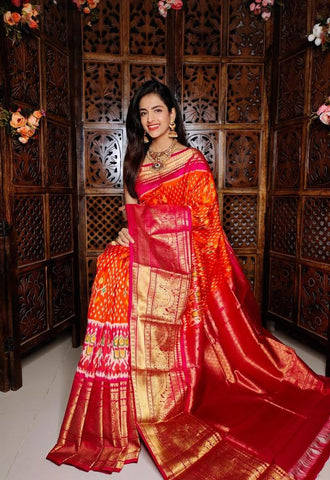
Day 2: Dwitiya - Brahmacharini
Mata Brahmacharini, the goddess celebrated on the second day, signifies eternal peace. White, the color of serenity, is the choice for Day 2.
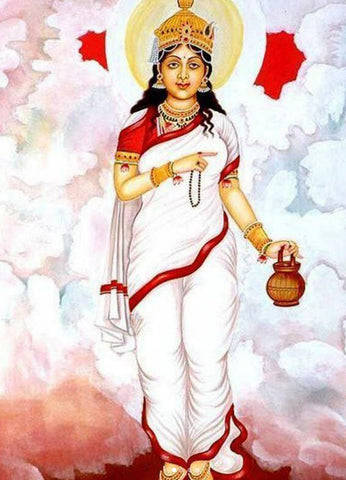
Image Courtesy: Online live daily news
A Pearl White Color Mirror Work Viscose Rayon Navaratri Lehenga Choli reflects the goddess's tranquil and pure nature.
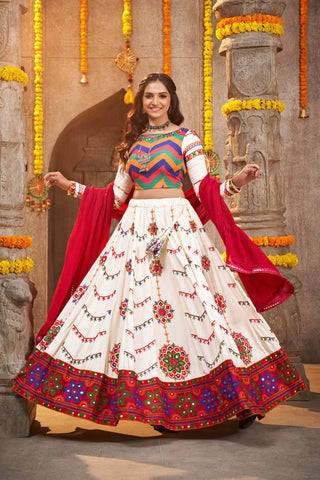
Day 3: Tritiya - Chandraghanta
On Tritiya, we worship Mata Chandraghanta, who rides a lion and is believed to vanquish evil forces. Red, the color of health, courage, and love, is the color of choice.
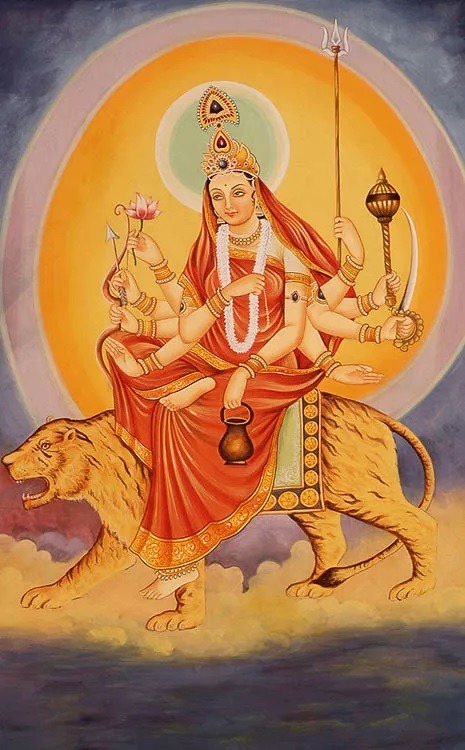
Image Courtesy: Pinterest
Embrace this vibrant hue with a Red saree cutdana work to channel your inner strength.
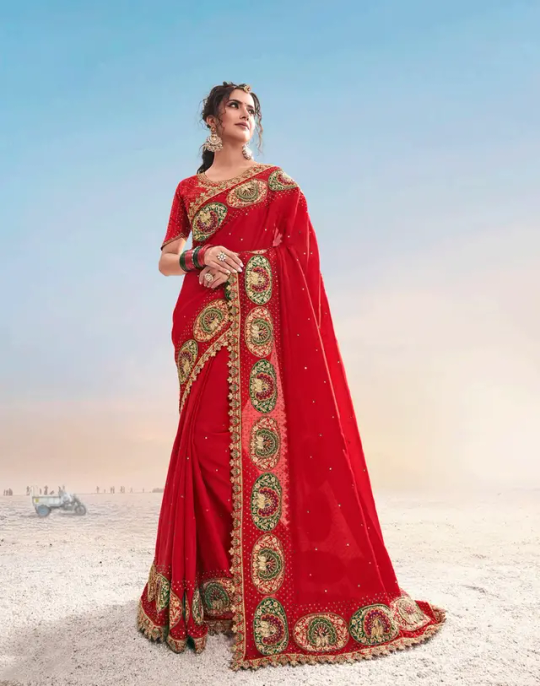
Day 4: Chaturthi - Kushmanda
The fourth day celebrates Mata Kushmanda, who is said to have created the cosmic egg with her smile, bringing light to the universe. Royal Blue, representing elegance and royalty, is the color for this day.

Image Courtesy: Pinterest
Grace the occasion with a splendid Navratri Chaniya Choli in this mesmerizing shade of Blue.
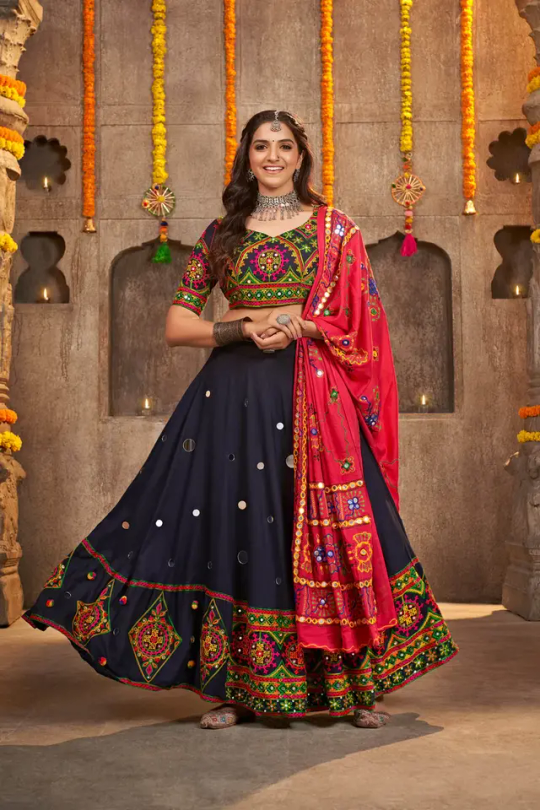
Image Courtesy: Pinterest
Day 5: Panchami - SkandMata
Mata Skandmata, honored on the fifth day, is associated with good health. This day is dedicated to Green, symbolizing nature and prosperity.

Image Courtesy: Pinterest
Wear this beautiful green saree to align with the goddess's blessings.

Day 6: Shashthi - Katyayani
Mata Katyayani, the sixth form of Mata Durga, is the granter of health and happiness. Grey, a vibrant and versatile color, is chosen for this day's celebrations.

Image Courtesy: Pinterest
Grace the occasion with a Grey Anarkali Dress
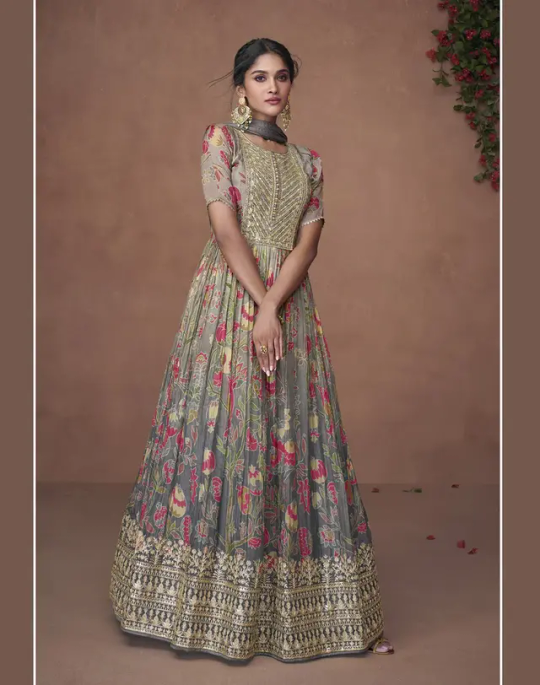
Day 7: Saptami - Kaalratri
Maa Kaalratri, worshipped on the seventh day, protects against evil forces. Orange is the color for Saptami, reflecting the fervor of Navratri celebrations.

Day 8: Ashtami - Mahagauri
Maa Mahagauri, associated with peace and intelligence, is revered on the eighth day.

Image Courtesy: Pinterest
Adorn yourself in Peacock Green indian saree, a sublime shade that complements the goddess's virtues.

Day 9: Navami - Siddhidatri
On the ninth and final day, we honor Maa Siddhidatri, the granter of divine blessings. Pink, a combination of the energy of red and the stability of blue, is chosen. This color symbolizes opulence and richness as we seek the goddess's supreme blessings.

Image Courtesy: Pinterest
During Navratri, people wear different colors each day to show that they are all together and devoted. It's like a colorful journey through different forms of the Goddess Durga, who is very special. When you celebrate Navratri, make sure to wear colors that show how much you love and respect the divine.
Explore the exquisite collection of Navratri attire at Mohi Fashion, featuring enchanting Chaniya Choli, Navratri Ghagra Choli, Anarkali suit, sarees, and stylish sharara suit, all available online. We proudly offer worldwide shipping, catering to fashion enthusiasts in the USA, Australia, UK, Canada, India, and beyond. Join us in celebrating the spirit of Navratri with elegance and style.
#navratri#lehenga#indian ethnic wear#sareelove#sareeonline#bride#wedding#indianfashion#sareecollection#bollywood#bollywood actress#ootd
2 notes
·
View notes
Video
youtube
Maha Gauri: The Eighth Day of Navratri (Ashtami) On the eighth day of Navratri, known as Ashtami, devotees worship **Maha Gauri**, the eighth incarnation of Goddess Durga. The name "Maha" signifies greatness, while "Gauri" stands for fairness and purity. According to Hindu mythology, Maha Gauri is a symbol of wisdom, peace, and purity. She rides a white bull and is depicted in white attire, symbolizing her pristine nature. Maha Gauri's story is connected to Goddess Parvati. After severe penance to win Lord Shiva's love, her body became pale and weak. Lord Shiva, pleased with her devotion, cleansed her with the holy waters of the Ganga, which restored her beauty and power, turning her into Maha Gauri. She is believed to grant peace and remove all suffering from her devotees, making her highly revered on this day. Significance: Worshiping Maha Gauri on Ashtami is believed to purify the heart and soul, as she represents inner beauty and tranquility. She also blesses her devotees with happiness, prosperity, and removes obstacles in their lives. നവരാത്രി എട്ടാം ദിവസം മഹാഗൌരി ദേവി നവരാത്രിയുടെ എട്ടാം ദിവസം, അഷ്ടമിദിനം, മഹാഗൌരി ദേവിയുടെ പൂജയാണ് നടത്തുന്നത്. "മഹ" എന്നത് മഹത്തരമായതും "ഗൌരി" ശുദ്ധിയുടെയും പ്രതീകവുമാണ്. മഹാഗൌരിയുടെ കഥ പാർവതി ദേവിയുമായി ബന്ധപ്പെട്ടതാണ്. തീവ്രമായ തപസ്യ നടത്തിയത് കൊണ്ട് പാർവതി ദേവിയുടെ ശരീരം ദുര്ബലമാകുകയും വർണ്ണം പോവുകയും ചെയ്തു. ശിവൻ അവളുടെ നിസ്തുലമായ സമർപ്പണം ��ണ്ടറിഞ്ഞ് ഗംഗാനദിയുടെ പരിശുദ്ധജലത്തിൽ അവളെ കഴുകി, അവൾക്ക് തിരികെയെത്തിയ ശോഭയോടെ മഹാഗൌരിയായി. The Eighth Day Of Navratri: Amalgamation of Power and Brilliance Due to her gleam and extraordinary brilliance, Maa Parvati came to be known as Mahagauri. She wears a white dress, rides a white-coloured bull, and has four arms. She holds a Trishul (trident), a lotus, and a drum in each of her hands. At the same time, she works with her fourth hand to favour all her devotees. Maa Mahagauri speaks to the virtue and internal excellence of every living being. She could be an adoring Goddess who takes care of her devotees and makes a difference by overcoming their troubles as well. Maa Mahagauri Vahan The carrier of Maa Mahagauri is a bull. In her depiction, she is shown as mounted on a bull and thus, is also known as Vrisharudha. Mahagauri Mantra ओम देवी महागौर्यै नमः॥ “Om Devi Mahagauryaye Namah” Mahagauri Prathna श्वेते वृषेसमारूढा श्वेताम्बरधरा शुचिः। महागौरी शुभं दद्यान्महादेव प्रमोददा॥ “Shwete Vrishesamaruda Shwetambra Shuchi| MahaGauri Shubham Dadhanmahadev Pramodda” Mahagauri Stuti या देवी सर्वभूतेषु माँ महागौरी रूपेण संस्थिता। नमस्तस्यै नमस्तस्यै नमस्तस्यै नमो नमः॥ ” Ya Devi Survabheteshu Ma Mahagauri Rupen Sansthita Namasteastaye Namasteastaye Namasteastaye Namo Namah” Maa Mahagauri Beej Mantra श्री क्लीं ह्रीं वरदायै नम:। ” Shree Klim Hrim Vardaye Namah” Significance Of Maa Mahagauri Puja It has been believed that worshipping Mata Mahagauri will eliminate all your sorrows and pains from your life. As she administers the malefic planet Rahu, asking her to evacuate the planetary absconds and an individual will be favoured with development and joy in life. Usually, Maha Ashtami is considered as a day when devotees ought to implore for evacuation of sufferings from their lives. #navratri2024 #maagauri #ashtami #durgaashtami #deviworship #hindufestivals #goddessworship #mahagauripuja #purity #divineblessings #bhakti #navratriworship #malayalamfestivals #raaganilavu #raaganilavusongs #രാഗനിലാവ് #malayalamlive #malayalam #sbtrendz #sbtrendzhealth #sbtrendzonline #bazznjazz #navdurga #navratri8thday #mahagauriashtami #vrisharudha #spirituality #bullmount #shivaandparvati #divinefeminine #navratri Navratri, Maha Gauri, Ashtami, eighth day, Mahagauri, Navdurga, Durga Puja, Durga Ashtami, Goddess Mahagauri, Parvati, Shakti, Hindu festival, bull mount, Gauri, purity, wisdom, Navratri 2024, Shubh Ashtami, divine feminine, Mahagauri puja vidhi, Navratri blessings, malayalam, raaganilavu, raaganilavusongs, malayalamlive, malayalam, sbtrendz, sbtrendzhealth, sbtrendzonline, bazznjazz, Mahagauri worship, inner peace, divine beauty, spiritual
0 notes
Text
Celebrating the Sacred: Chaitra Navratri 2024
https://hindi.oneworldnews.com/religious/chaitra-navratri-2024-chant-mantras/
Chaitra Navratri, a nine-day festival dedicated to the worship of Goddess Durga, holds immense significance in Hindu culture. Occurring in the Hindu lunar month of Chaitra, typically falling in March or April, this auspicious occasion marks the beginning of the Hindu New Year and heralds the arrival of spring. In 2024, Chaitra Navratri spans from March 28th to April 5th, offering devotees a spiritually enriching opportunity to invoke the divine blessings of the Goddess and embark on a journey of self-discovery and transformation.
Navratri, which translates to "nine nights," symbolizes the triumph of good over evil and the importance of righteousness in our lives. Each day of Navratri is dedicated to a different form of Goddess Durga, known as Navadurga, and devotees observe various rituals and traditions to honor her divine presence. From elaborate puja ceremonies to vibrant cultural celebrations, Chaitra Navratri is a time of fervent devotion and communal harmony.
The first day of Chaitra Navratri is marked by the worship of Goddess Shailaputri, the embodiment of divine energy and purity. Devotees adorn themselves in vibrant attire, offer prayers, and seek blessings for prosperity and well-being. As the festival progresses, each subsequent day is dedicated to worshipping different forms of Goddess Durga, including Brahmacharini, Chandraghanta, Kushmanda, Skandamata, Katyayani, Kaalratri, Mahagauri, and Siddhidatri.
One of the highlights of Chaitra Navratri is the performance of Dandiya and Garba, traditional folk dances that symbolize joy, unity, and devotion. People come together in community spaces adorned with colorful decorations, singing and dancing to the rhythmic beats of traditional music. These lively cultural events foster a sense of camaraderie and celebration, reinforcing the spirit of Navratri.
During Chaitra Navratri, devotees also observe fasting as a form of penance and purification. While some choose to abstain from consuming grains and certain foods throughout the nine days, others opt for stricter dietary restrictions, consuming only fruits, milk, and non-grain items. Fasting is believed to cleanse the body and mind, enabling devotees to focus their energies on spiritual pursuits and deepen their connection with the divine.
Apart from traditional rituals and customs, Chaitra Navratri also serves as a time for introspection and renewal. It is an opportunity for individuals to reflect on their thoughts, actions, and aspirations, and to seek guidance from the Goddess in overcoming obstacles and achieving success in their endeavors. Through prayer, meditation, and acts of charity, devotees strive to cultivate virtues of compassion, humility, and gratitude, fostering personal growth and spiritual enlightenment.
In conclusion, Chaitra Navratri 2024 is a sacred occasion that holds profound significance in Hindu culture. It is a time of reverence, celebration, and spiritual awakening, as devotees come together to honor the divine feminine and seek her blessings for prosperity and happiness. As we embark on this nine-day journey of devotion and self-discovery, may the divine grace of Goddess Durga illuminate our path and fill our hearts with joy, peace, and fulfillment.
1 note
·
View note
Text
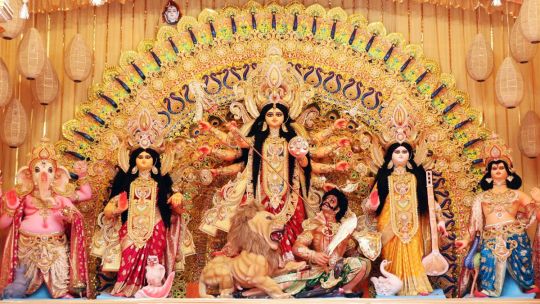
Unveiling the Colors, Rhythms, and Joys of Navratri Festival and Garba Dance
Festivals / By lovenheal
Introduction
Navratri, a vibrant and enchanting festival celebrated in India, holds a special place in the hearts of millions. With its roots in Hindu mythology, Navratri is a nine-night festival dedicated to the worship of the goddess Durga. It’s not just about prayer, though; Navratri is a time for cultural celebrations, delicious food, and the mesmerizing Garba dance. In this blog, we will delve into the captivating world of Navratri and the Garba dance, exploring the history, significance, and how to make the most of this incredible festival.
The Origins and Significance of Navratri
Navratri, meaning “Nine Nights,” is celebrated in the honor of the divine feminine energy, Shakti. These nine nights are divided into three sets of three days, each devoted to a different form of the goddess Durga: Durga, Lakshmi, and Saraswati. The festival usually falls in September or October, coinciding with the change of seasons.
The significance of Navratri is profound. It symbolizes the triumph of good over evil, as it marks the victory of goddess Durga over the demon Mahishasura. During these nine days, devotees engage in prayer, fasting, and meditation to cleanse their bodies and minds.
The Colors of Navratri
Each day of Navratri is associated with a specific color. Wearing these colors is believed to bring blessings and positive energy. The colors are as follows:
Yellow: This color signifies the beginning of the festival and the presence of goddess Shailputri, the daughter of the Himalayas.
Green: The second day is dedicated to goddess Brahmacharini, who is worshipped in green attire.
Grey: This day honors goddess Chandraghanta, symbolized by the color grey.
Orange: The fourth day represents the goddess Kushmanda and the color orange.
White: Devotees wear white on this day, dedicated to goddess Skandamata.
Red: The color red is associated with the goddess Katyayani, whose blessings are sought on the sixth day.
Royal Blue: This day is dedicated to goddess Kalratri, who is worshipped in royal blue attire.
Pink: Goddess Mahagauri is celebrated on the eighth day, and devotees adorn themselves in pink.
Purple: The final day of Navratri is marked by the color purple, which represents goddess Siddhidatri.
The Joy of Garba Dance
One of the highlights of Navratri is the Garba dance, a traditional Gujarati folk dance that symbolizes unity and devotion. Garba, meaning “womb,” is a dance that celebrates the circle of life. Here’s how you can enjoy and participate in this vibrant dance:
Dress in Traditional Attire: Garba attire typically includes chaniya cholis for women and kediyu-dhoti for men, often adorned with mirror work and vibrant colors.
Learn the Steps: Garba dance steps are graceful and rhythmic. You can join local classes or find online tutorials to master the moves.
Celebrate with Music: Garba music is melodious and lively. Traditional instruments like dhol, dandiya sticks, and electronic music create an electrifying atmosphere.
Participate in Garba Nights: Many communities and cities organize Garba nights during Navratri. Join these events to experience the joy of dancing with others.
Respect the Traditions: While enjoying the dance, remember the cultural and spiritual significance. Garba is not just a dance but a form of worship as well.
Navratri is a festival that brings people together, celebrating the diversity and unity of Indian culture. The colorful attire, the melodious music, and the joyful Garba dance make it a truly unique experience. By understanding the history and significance of Navratri and embracing the dance, you can fully immerse yourself in the festivities and create lasting memories. So, join the revelry, dance your heart out, and experience the magic of Navratri and Garba. Happy Navratri!
0 notes
Text
Unveiling the Mysteries of the 8th Day of Navratri
Navratri, a constellation of light, devotion, and festive vigor, holds a cherished place in the Indian festival calendar. The eighth day, often referred to as 'Ashtami,' holds a unique significance in these celebrations. This day is graced by the puja of Goddess Mahagauri, the eighth form of Goddess Durga, known for her radiant beauty and immense power. Join us as we dive deeper into the mysteries and beauty of the 8th Day of Navratri.

The Divine Form: Goddess Mahagauri Mahagauri symbolizes purity and calmness. She is worshipped for her ability to absolve devotees of their sins and help them purify their lives. Dressed in white with four hands, she is mounted on a bull—her calm and serene face radiating peace and power.
Rituals and Celebrations The 8th day begins with a ritual bath, followed by a special puja offered to Goddess Mahagauri. She is adorned with colorful flowers, and the ceremonial 'arti' concludes the morning rituals. Many observers fast on this day as well, partaking in a special diet of 'vrat' food.
In the evening, devotees repeat the puja and offer prayers, followed by the main event—'Kanya Puja'. In this ritual, nine young girls are invited into homes, their feet washed symbolizing the goddess's entrance, and are offered food and new clothes. This ritual is highly significant as it is seen as directly worshipping the goddess herself.
Beliefs and Legends According to Hindu mythology, Parvati undertook rigorous penance to have Lord Shiva as her husband. For years, she survived on fruits and later even on leaves, which turned her complexion dark. Pleased with her dedication, Lord Shiva granted her the wish, and she bathed in the holy Ganga water. This bath turned her skin golden, and hence she was called Mahagauri, the extremely fair one.
The story of Mahagauri teaches us that determined devotion and penance can lead to the fulfillment of our deepest desires. Her worship on the 8th day represents breaking free from earthly bonds to attain spiritual awakening.
The Golden Day The color associated with the 8th day is pink, symbolizing optimism and warmth. Devotees dress in pink and decorate the goddess in pink attire too. Singing, dancing, and feasting characterize the celebration on this day, creating an atmosphere of joy and devotion.
Thus, the 8th day of Navratri is a blend of spiritual significance, fervor, and jubilation. Unpacking the mystery of this day helps us understand the beauty of celebration and devotion to Goddess Durga and her different forms.
1 note
·
View note
Text
9 Ways to Choose the Right Navratri Chaniya Choli Colors for a Spiritually-Inspired Celebration

Navratri, a vibrant and joyous festival celebrated in India, is a time of devotion, dance, and merriment. During these nine nights dedicated to the worship of the Hindu goddess Durga, people adorn themselves in colorful traditional attire to honor the divine feminine energy. The choice of colors for Navratri chaniya cholis holds deep spiritual significance and adds to the festive fervor. Let's explore the nine colors associated with each day of Navratri and their symbolism, and learn how to select the right chaniya choli colors that reflect your personality and style.
The 9 colors associated with each day of Navratri and their symbolism:
Day 1 - Yellow: The color yellow symbolizes brightness, positivity, and new beginnings. It represents the energy of the goddess Shailputri, the embodiment of nature's power.
Day 2 - Green: Green represents fertility, harmony, and prosperity. It is associated with the goddess Brahmacharini, who signifies devotion and love.
Day 3 - Grey: Grey represents balance, stability, and protection. This color is linked to the goddess Chandraghanta, known for her courage and grace.
Day 4 - Orange: The color orange signifies enthusiasm, creativity, and spiritual awakening. It represents the goddess Kushmanda, the creator of the universe.
Day 5 - White: White represents purity, peace, and clarity. It is associated with the goddess Skandamata, who signifies motherly love and compassion.
Day 6 - Red: Red symbolizes power, passion, and energy. It is linked to the goddess Katyayani, who embodies fearlessness and strength.
Day 7 - Royal Blue: Royal blue represents intelligence, wisdom, and stability. This color is associated with the goddess Kalratri, the protector who destroys negativity.
Day 8 - Pink: Pink signifies love, beauty, and affection. It is linked to the goddess Mahagauri, who represents purity and serenity.
Day 9 - Purple: Purple represents spirituality, enlightenment, and transformation. It is associated with the goddess Siddhidatri, the bestower of knowledge and divine grace.
How to choose the right chaniya choli colors for your individual personality and style:
When selecting chaniya choli colors for Navratri, consider your personality and personal style. Each color carries its own energy and can complement different individuals. Let’s look at the below ways to choose a right chaniya choli color as per your personality and style:
Reflect on your personality traits: Consider your temperament and characteristics. If you're lively and outgoing, vibrant colors like orange or red may suit you. For a calm and serene personality, white or pink may be more appealing.
Explore color symbolism: Understand the symbolism behind each color and choose one that resonates with your intentions and aspirations. For instance, if you seek transformation and spiritual growth, purple might be an ideal choice.
Consider your complexion: Certain colors can enhance your natural beauty. For instance, warm hues like yellow and orange can complement darker skin tones, while pastel shades like pink and green can enhance fairer complexions.
Experiment with contrasts: If you want to make a bold statement, consider contrasting colors. For example, pairing a yellow choli with a royal blue ghagra can create a visually striking ensemble.
Embrace personal preferences: Ultimately, choose colors that make you feel confident and comfortable. Listen to your intuition and follow your instincts when selecting your Navratri chaniya choli colors.
Tips for accessorizing your chaniya choli to complement the colors you choose:
Accessorizing your chaniya choli can elevate your Navratri style and complement the chosen colors. Below listed are a few tips that can enhance your holistic elegance.
Jewelry: Select jewelry that complements your chaniya choli and adds a touch of elegance. Ethnic Gujrati style articifial, silver or gold ornaments such as chandelier earrings, necklaces and bangles can elevate your beauty holistically.
Footwear: Choose footwear that matches your chaniya choli's color palette. Embroidered mojaris, colorful juttis, or embellished sandals are popular choices that can add a traditional touch to your ensemble.
Dupatta or scarf: If your chaniya choli doesn't include a dupatta, consider adding one in a contrasting or complementary color. It can be draped gracefully over your shoulder or used as a headscarf.
Hairstyle and makeup: Coordinate your hairstyle and makeup with your outfit. Opt for traditional hairstyles like braids, buns, or open curls, and use makeup that enhances your features while complementing the overall color scheme.
Where to find beautiful chaniya choli in the 9 colors of Navratri:
Finding the perfect chaniya choli for Navratri is an exciting part of the celebration. You can explore various options to discover beautiful outfits in the nine Navratri colors:
Local markets: Visit local markets known for their traditional attire and ethnic wear. These markets often offer a wide range of chaniya cholis in different colors, designs, and price ranges.
Online platforms: Numerous online platforms and marketplaces specialize in ethnic wear. You can browse through their collections, filter by color, and find chaniya cholis that suit your style.
We at Sannari have multiple options available of Navratri style ghagra choli for women.
We hold the belief that each individual possesses a unique identity, and our designs should effectively embody this notion.
Provided below are some of our designs for your future reference.

Jazzy Rayon Garba Wear Chaniya Choli For Navratri
Let us delve into the elaborate details and exclusivity of our exquisite creation, the rayon garba wear chaniya choli. This ensemble is meticulously designed to capture attention and create a lasting impression.
Crafted from high-quality rayon fabric, the chaniya choli exudes a luxurious feel while ensuring comfort and ease of movement. The fabric's soft texture adds to the overall appeal of the outfit.
What truly sets this garment apart is its remarkable ajrakh print and bandhej print. The ajrakh print, renowned for its traditional and ethnic charm, features intricate patterns and motifs inspired by the rich cultural heritage of India. This print lends a sense of artistry and authenticity to the ensemble, making it a standout piece.
Additionally, the bandhej print adds a touch of elegance and sophistication to the chaniya choli. Bandhej, also known as tie and dye, involves a meticulous process of tying and dyeing the fabric to create unique and mesmerizing patterns. The combination of the ajrakh and bandhej prints results in a visually captivating ensemble that truly catches the eye. The model images provided are solely representative, serving as an inspiration to visualize how the chaniya choli may look when worn. The actual product may differ slightly in appearance, allowing each wearer to embrace their own individual style.

Fantastic Cotton Garba Wear Chaniya Choli For Navratri
Experience the enchantment of a fairy tale coming to life with this exquisite garment. As you gracefully adorn yourself in this captivating attire, the story begins to unfold, revealing your inherent beauty. Immerse yourself in the allure of ethnic fashion with this stunning chaniya choli, crafted from fantastic cotton fabric.
Every detail of this lovely ensemble exudes elegance and charm, enhanced by the intricate traditional prints and exquisite traditional work adorning its surface. The garment is thoughtfully designed, featuring a matching choli (blouse) and dupatta (scarf) that perfectly complement the overall aesthetic.
Conclusion:
Navratri is a celebration of colors, spirituality, and cultural traditions. Choosing the right chaniya choli colors adds to the festive spirit and helps you connect with the divine energy associated with each day of the festival. By considering your personality, exploring color symbolism, and experimenting with accessories, you can create a visually captivating and spiritually-inspired Navratri style. Embrace the vibrant hues, express your individuality, and immerse yourself in the joyous celebration of Navratri with the perfect chaniya choli in hand.
#navratri chaniya choli colors#navratri fashion colors for navratri#how to choose navratri colors#navratri colors#ghagra choli for women#navratri ghagra choli
0 notes
Photo

Day 8 - Ashtami - #Purple Day eighth of #navratri is known as #Ashtami. On this day, #GoddessDurga is worshiped as #MahaGauri. The attire that devotes will wear on this day should be of purple color. The Goddess purifies her worshipers and also forgives their sins. The Goddess as Maha Gauri performed a penance so that she may have Lord Shiva as her husband. During the course of the penance, dust accumulated on her body and Lord Shiva washed it with the sacred waters of the Ganga. #SaraswatiMata Puja is also organized on this day. https://www.instagram.com/p/B3SVgZajryx/?igshid=6gnd4c5d3fi2
1 note
·
View note
Text
Navratri 2022 is round the corner: Here is your whole guide!
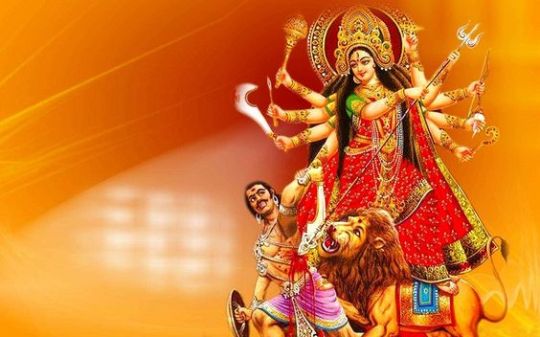
Chaitra Navratri 2022 is celebrated with zeal in India, and it also marks the beginning of the Hindu New Year.
People all across the world observe worship on these days because they are the most potent and auspicious for worship. Little girls' feet are frequently touched.
Hinduism holds Navratri 2022 to be a particularly sacred day.
The Maha Navratri 2022
This Navratri is also known as Shardiya Navratri and Maha Navratri. This year's Navratri will begin on September 26 and will remain through Wednesday, October 5.
Shardiya Navratri begins on Monday this year. This time, Goddess Durga will enter the globe riding an elephant, which will be exceedingly lucky for everyone in a variety of ways.
When?
Monday, September 26th is Ghatasthapana, Monday, October 3rd is Durgashtami, and Tuesday, October 4th is Maha Navami.
Time and Muhrat: Navratri 2022
Ghatasthapana Muhurat is on September 26 from 6:20 AM to 10:19 AM.
Pratipada Tithi falls on September 26 at 3:24 a.m. and September 27 at 3:08 a.m.
This event is observed for nine nights. and such is India's beauty! Every day, devotees honour a different Durga Maa incarnation.
Get face reading by the best astrologers online in India, connect with face reading astrologers at https://helloastro24.com/
Nine forms of Goddess Durga at Navratri.
Day 1: Prapada/Shalaputri
Pratipada worships the deity Shailaputri. Putri denotes a daughter, but Shaila denotes a mountain. Goddess Parvati is also given attention.
On this day, because she is the daughter of the Mountain God.
Day 2: Dwitya/Brahmacharini
Dwitiya's Goddess Brahmacharini is a manifestation of Durga Devi who soothes rage. As a result, on the second day, bhakts honour this Goddess.
Day 3: Tritya/Chandraghanta
On Tritiya, devotees worship Chandraghanta. People think she has third sight and can see evil spirits. It is auspicious to please her with Jasmine blossoms.
Day 4: Kushmanda/Chaturthi
On the fourth day, people worship Goddess Kushmanda. Her name means "cosmic egg," because she offers warmth and life to everyone.
Day 5: it is Skandamata/Panchami.
Panchami, the Goddess Skandamata, is Buddha's monarch (the Mercury planet). She is beloved since she is reported to be tenacious and caring.
Day 6: Katyayini and Shashti
Durga, according to tradition, took the form of Devi Katyayani on the sixth day, Shashti, to defeat the Master of Demons. Women pray for a happy marriage and family life.
Day 7: Saptami and Kalaratri
Saptami is specifically dedicated to the deity Kalaratri. She is said to be terrifying and to have terrified evil spirits from all across the world. She is Lord Shani's ruler and the most dreadful form of Kali Devi (Saturn Planet).
Day 8: Ashtami/Mahabgaur
Mahagauri is worshipped on the eighth day. She only wears white attire and rides a bull on this specific day. On this day, a special celebration for young virgin females called Kanya Puja takes place. This day is referred to as Mahashtami or Maha Durgashtami. To commemorate the occasion, dance, entertainment, and prayers are used.
Day 9: Navami/Siddhidaatri
On Navami, it is necessary to remember Devi Siddhidaatri. She is powerful enough to grant all of your wishes, thus the 9th day is dedicated to her.
10th day: Vijayadashami (Dussehra)
After nine days of devotion, the tenth day is set aside for Vijayadashmi. a day when new beginnings are conceivable in life
Navratri food suggestions
During the Navratras fast, popular foods include Sabudana Vada (also known as Sago Vada), Sabudana Khichadi (also known as Sago Khichadi), Singhare Ka Halwa (also known as Water Chestnut Flour Desserts), Kuttu Ki Poori (also known as Grass Seed Bread or Quinoa Poori), and Singhare Ke Pakore.
Observing all of the ceremonies and rituals linked with the entire 9-day Navratri celebration helps to bring wealth and happiness into the devotees' hearts.
According to Hindu custom, the nine days of Navratri are the most auspicious of the year, and Hindus all throughout the country celebrate with great zeal and devotion. Devotees fast for nine days to gain self-control and to explore the spiritual realm.
Get your free online Janam Kundali online from our best online astrologer at HelloAstro24. It helps you predict the future for yourself by reading the birth chart. https://helloastro24.com/freekundali/
0 notes
Text
Significance of 9 days of Navratri

Navaratri is a Hindu festival and is celebrated every year in the month of September-October. The Word Navratri in Sanskrit means “Nine nights”. Celebrations include stage decorations, recital of the legend, dancing and chanting of the scriptures of Hinduism. Everyone decorate and worship their equipment, machinery, and tools of trade. Students visit their teachers, express respect and seek their blessings. There are total of four Navratri’s this one is called SHARAD NAVRATRI which is most significant. The nine days also refers to the 9 goddesses of this festival where we worship feminine power. And bestow blessings upon us.
Day 1: Shailaputri
Shailaputri is an avatar of Goddess Durga, who was born in the house of King of Mountains “Parvat Raj Himalaya”. The name “Shailaputri” literally means the daughter (putri) of mountain (shaila). It is also the first form of goddess Durga (Parvati)
Goddess Shailaputri is depicted with two hands and has a crescent moon on her forehead. She holds a trident in her right hand and a lotus flower in the left. She rides on mount Nandi (bull).
The colour for first day is Orange.
WorshippingGoddess Shailaputrihelps us to evolve higher into the spiritual path.
Mantra of Shailaputri:
Om Devi Shailaputryai Namah॥

Day 2: Brahmacharini
Brahmacharini means a devoted female student who lives in an Ashrama with her Guru along with other students. It is also the name of the second aspect of the goddess Durga (Parvati).Depicted as walking bare feet and holding a japamala and kamandal in her hands, she symbolizes bliss and calm. The colour of second day is white
The colour of second day is White.
Worshipping goddess Brahmacharini helps us on a path of self-discipline and austerity.
Mantra of Brahmacharini:
Om Devi Brahmacharinyai Namah॥
Day 3: Chandraghanta
In Hinduism, Chandraghanta is the third form of Goddess Durga. Her name Chandra-Ghanta, means "one who has a half-moon shaped like a bell. Her third eye is always opened and she always ready for war against demons". This is also the third form of goddess Durga (Parvati)
Chandraghanta has ten hands where two hands hold a Trishula(trident), Gada(mace), bow-arrow, khadak(sword), Kamala(lotus flower), Ghanta(bell) and kamandal(waterpot), while one of her hands remains in blessing posture or abhayamudra.
The colour of third day is Red.
Worshipping goddess Chandraghanta helps devotees with her grace, bravery and courage. By her grace all the sins, distresses, physical sufferings, mental tribulations and ghostly hurdles of the devotees are eradicated.
Mantra of Chandraghanta:
Om Devi Chandraghantayai Namah॥
Day 4: Kushmanda
Her name signals her main role: Ku means "a little", Ushma means "warmth" or "energy" and Anda means "cosmic egg". Believed to be the creative power of universe, Kushmanda associated to the endowment of vegetation on earth. This is also the fourth form of goddess Durga (Parvati)
She is depicted as having eight arms and sits on a Tiger. Goddess Kushmanda has eight hands and because of that She is also known as Ashtabhuja Devi. It is believed that all the power to bestow Siddhis and Niddhis are located in her Jap Mala.
The colour of fourth day is Royal Blue. Worshipping goddess Kushmanda improves health and bestow wealth and strength.
Mantra of Kushmanda:
Om Devi Kushmandayai Namah॥
Day 5: Skandmata
Skandamata, the goddess worshiped on Panchami. Skanda is another name for war god and her son Kartikeya and Mata is the term for mother. This is also the fifth form of goddess Durga (Parvati).
The colour She is depicted riding a ferocious lion, having four arms and holding her baby.
It is believed that she awards devotees with salvation, power, prosperity and treasures. She can grant oceans of wisdom even to most illiterate person, if he happens to worship her. Her worship is twice blessed. When the devotee worships her, Lord Skand, her son in her lap, is automatically worshipped. Thus, the devotee happens to enjoy the grace of Skandmata along with the grace of Lord Skand. The devotees who worship Skandamātā shine with divine splendour. Her worship is ultimately conducive to salvation. She is regularly known as "The Goddess of Fire".
The colour of fifth day is Yellow.
Mantra of Skandmata:
Om Devi Skandmatai Namah॥
Day 6: Katyayani
Born to a sage, Katyayana, she is an incarnation of Durga and is shown to exhibit courage Known as the warrior goddess, she is considered one of the most violent forms of Goddess Parvati. This is also the sixth form of goddess Durga (Parvati).
Kātyāyanī is depicted as the one who rides a lion and has four hands.
Worshipping goddess Katyayani helps young unmarried girls to have husbands of their choice, there is a story behind this:-
"During the month of Mārgaśīrṣa, every day early in the morning the young daughters of the cowherds(gopis) would take one another's hands and singing of Krishna's transcendental qualities, go to the Yamuna(Jamuna) to bathe. Desiring to obtain Krishna as their husband, they would then worship the goddess Kātyāyanī with incense, flowers and other items".
The fasting, called Kātyāyanī-vrata is made for a whole month, offering such things as sandal, flowers, incense, etc.
The colour of sixth day is Green.
Mantra of Katyayani :
Om Devi Katyayanyai Namah॥
Day 7: Kalaratri
The first part of the word kalaratri is kala. Kala primarily means time but also means black in honour of being the first creation before light itself. This form primarily depicts that life also has a dark side – the violence of Mother Nature that encompasses death and destruction. This is also the seventh form of goddess Durga (Parvati)
Kalaratri is the Goddess that is depicted in a white colour attire with a lot of rage in her fiery eyes, her skin turns black.
Worshipping goddess Kalaratri portrays prayer and peace, and ensures the devotees that the Goddess will protect them from harm. This form of Goddess is believed to be the destroyer of all demon entities, ghosts, spirits and negative energies, who flee upon knowing of her arrival. Invoking Goddess Kaalratri therefore empowers the devotee with the devouring quality of kala (time) and the all-consuming nature of ratri (night) - allowing all obstacles to be overcome and guaranteeing success in all undertakings. In summary, Kaalratri is the personification of the night of all-destroying time.
The colour of seventh day is Grey.
Mantra of Kaalratri:
Om Devi Kaalratryai Namah॥
Day 8: Mahagauri
The name Mahagauri means extremely white, as she was white in colour and very beautiful (Mahā, = great; Gaurī, = white). This is also the eighth form of goddess Durga (Parvati).
Mahagauri is usually depicted with four hands, the hands holding a trident, lotus and drum, while the fourth is in a blessing gesture. The lotus is sometimes replaced with a rosary. She rides a white bull, usually shown wearing white clothes.
Worshipping Goddess Mahagauri has many benefits. She is auspicious, brilliant and protects the good people while punishing those who perform evil deeds. Mother Gauri enlightens the spiritual seeker and removes the fear of rebirth by granting salvation.
The colour of Eighth day is Purple.
Mantra of Mahagauri :
Om Devi Mahagauriyai Namah॥
Day 9: Siddhidhatri
The meaning of her name is as follows: Siddhi means supernatural power or meditative ability, and Dhatri means giver or awarder. This is the ninth and final form of goddess Durga (Parvati).
She is depicted as sitting on a lotus, she is believed to possess and bestows all type of Siddhis. Here she has four hands. She holds a lotus, mace, Sudarshana Chakra and shankha. Also known as Saraswati Devi.
Worshipping Goddess Sidhremoves ignorance and she provides the knowledge to realize that or Brahman. She is surrounded by Siddhas, Gandharvas, Yakshas, Devas (Gods) and Asura (Demons) worship her. The Siddhi that she provides is the realization that only she exists. She is the mistress of all achievements and perfections.
The colour of Ninth day is Peacock Green.
Mantra of Siddhidhatri:
Om Devi Siddhidhatryai Namah॥
0 notes
Text
Navratri 2024 Colors: A Guide to the Significance of 9 Days of Sharad Navratri Attire

Navratri, the nine-night festival dedicated to the worship of Goddess Durga, is celebrated with great enthusiasm and devotion in India, especially in states like Maharashtra and Gujarat. One of the captivating traditions during Navratri is the daily choice of colors to wear, each associated with a different form of the goddess. This practice holds deep significance in Hindu culture, symbolizing purity. Let's take a closer look at the Navratri colors to be followed this year and the gods and goddesses they represent.
Day 1: Pratipada - Shailputri
On the first day of Navratri, Goddess Shailputri is venerated, also known as Parvati, the daughter of the Himalaya mountains. The color for this day is Orange, symbolizing energy and enthusiasm.
Image Courtesy: Pinterest
Adorn yourself in an elegant Orange and red Ikkat Pure Pochampally Handloom Saree to honor the goddess's strength and grace.

Day 2: Dwitiya - Brahmacharini
Mata Brahmacharini, the goddess celebrated on the second day, signifies eternal peace. White, the color of serenity, is the choice for Day 2.

Image Courtesy: Online live daily news
A Pearl White Color Mirror Work Viscose Rayon Navaratri Lehenga Choli reflects the goddess's tranquil and pure nature.

Day 3: Tritiya - Chandraghanta
On Tritiya, we worship Mata Chandraghanta, who rides a lion and is believed to vanquish evil forces. Red, the color of health, courage, and love, is the color of choice.

Image Courtesy: Pinterest
Embrace this vibrant hue with a Red saree cutdana work to channel your inner strength.

Day 4: Chaturthi - Kushmanda
The fourth day celebrates Mata Kushmanda, who is said to have created the cosmic egg with her smile, bringing light to the universe. Royal Blue, representing elegance and royalty, is the color for this day.

Image Courtesy: Pinterest
Grace the occasion with a splendid Navratri Chaniya Choli in this mesmerizing shade of Blue.

Day 5: Panchami - SkandMata
Mata Skandmata, honored on the fifth day, is associated with good health. This day is dedicated to Green, symbolizing nature and prosperity.

Image Courtesy: Pinterest
Wear this beautiful green saree to align with the goddess's blessings.

Day 6: Shashthi - Katyayani
Mata Katyayani, the sixth form of Mata Durga, is the granter of health and happiness. Grey, a vibrant and versatile color, is chosen for this day's celebrations.
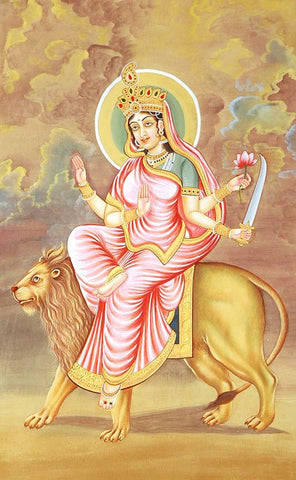
Image Courtesy: Pinterest
Grace the occasion with a Grey Anarkali Dress

Day 7: Saptami - Kaalratri
Maa Kaalratri, worshipped on the seventh day, protects against evil forces. Orange is the color for Saptami, reflecting the fervor of Navratri celebrations.

Day 8: Ashtami - Mahagauri
Maa Mahagauri, associated with peace and intelligence, is revered on the eighth day.

Image Courtesy: Pinterest
Adorn yourself in Peacock Green indian saree, a sublime shade that complements the goddess's virtues.

Day 9: Navami - Siddhidatri
On the ninth and final day, we honor Maa Siddhidatri, the granter of divine blessings. Pink, a combination of the energy of red and the stability of blue, is chosen. This color symbolizes opulence and richness as we seek the goddess's supreme blessings.

Image Courtesy: Pinterest
During Navratri, people wear different colors each day to show that they are all together and devoted. It's like a colorful journey through different forms of the Goddess Durga, who is very special. When you celebrate Navratri, make sure to wear colors that show how much you love and respect the divine.
Explore the exquisite collection of Navratri attire at Mohi Fashion, featuring enchanting Chaniya Choli, Navratri Ghagra Choli, Anarkali suit, sarees, and stylish sharara suit, all available online. We proudly offer worldwide shipping, catering to fashion enthusiasts in the USA, Australia, UK, Canada, India, and beyond. Join us in celebrating the spirit of Navratri with elegance and style.
More:
Navratri Chaniya Choli
Guide to the Significance of Navratri
Garba: Significance of Garba Forms in Navaratri
Dressing Up for Dandiya Night
1st day Navratri | Maa Shailputri
#navratri#garba#dandiya#durga puja#lehenga choli#wedding guest dresses#indian wedding dresses#indian ethnic wear
0 notes